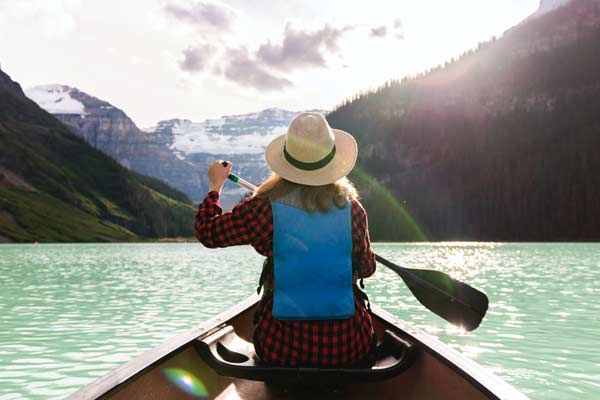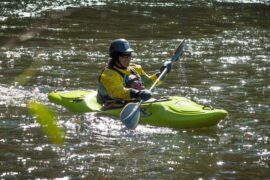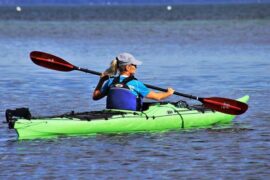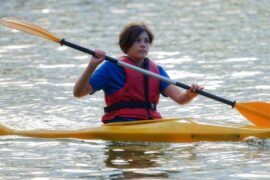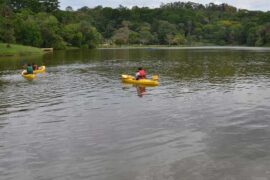Do you enjoy going out on the water in a kayak or a canoe? Either option is a great way to get in some time experiencing the great outdoors and some exercise. But which one is more likely to bring about an unexpected dip in the water?
You’re more likely to flip a kayak when it comes to kayaks and canoes. Why’s that? Their design sacrifices stability in honor of speed and agility.
You’ll move along much faster in a kayak than in a canoe, but chances are you’ll get where you’re going a lot drier in a canoe. However, the type of kayak and the conditions you go out in affect stability the most.
Which Is Easier to Flip Canoe or Kayak
The short and simple answer is that it is easier to flip a kayak than a canoe. A kayak’s hull is designed to be fast and agile, while a canoe is designed for stability more so than speed.
Overturned kayaks are a lot easier to the right than overturned canoes. You’re in trouble if you’re on your own or a decent distance from the shore and manage to capsize your canoe.
Why Is a Canoe More Stable?
The difference between the two is in their shapes. Kayaks have a slim design that allows them to cut through the water with increased speed.
They are not constructed with a focus on stability, which is sacrificed to improve speed and maneuverability. Navigating, moving forward, and paddling is easier in a kayak.
Canoes, however, are designed around stability. Their hulls are immersed deep in the water, creating resistance. This resistance makes it less likely that the vessel will come out of the water and flip.
The wide shape of canoes also lends to their stability. However, these factors cause canoes to move more slowly and be more challenging to maneuver.
What to Do if You Flip Your Canoe or Kayak
While capsizing your canoe or kayak will be a scary experience, it doesn’t have to be a disaster. Make sure you stay calm and follow these tips.
- Dress for the water: You’re going out on the water, so you need to assume there’s a chance you’ll end up in it. Don’t dress for the weather. Dress like you’re going to be submerged in icy, cold water.
- Wear a life jacket: Did you know that most drowning fatalities related to boating accidents did not have life jackets? Be safe and wear yours.
- Practice: You need experience rescuing yourself to know what to expect if you ever capsize. This means turning your canoe or kayak over and emptying the hull of enough water to make it back to shore.
- Secure your gear: If you have gear on your canoe or kayak, you need to tie it down. It needs to be stowed in stuff sacks or dry bags to protect it in the event of capsizing.
- Stay calm: The most important thing you can do is not panic. You must keep a level head to remain safe and get your kayak or canoe turned back over.
Preventing Your Kayak From Capsizing
While they are more likely to capsize than canoes, kayaks aren’t exactly designed to go around flipping over. Two main factors affect the possibility of having an incident, the type of kayak you’re in and the weather conditions.
You must ensure you have the right kayak for the right conditions. For example, if you take a recreational kayak out on calm water, you’re almost guaranteed to remain upright the entire time.
On the other hand, if you take a sea or ultralight kayak out on the whitewater, your chances of flipping over increase exponentially.
It’s impossible to prevent flipping over entirely, but you can drastically reduce the probability, especially if you follow these steps.
Go Out in the Right Weather
You should avoid inclement weather whenever possible. The weather plays a major part in kayak safety. Strong winds can increase wave sizes, which can cause your kayak to flip over. Remember, there’s always another time you can go out if the weather is bad today.
Make Sure Your Kayak Is Balanced
You need to ensure that whatever load you are carrying with you is balanced. Otherwise, you will have difficulty using your torso to balance your kayak. It should be evenly balanced from one end of the kayak and from one side to the other.
When you sit up straight, there should be no balance problems. If you skip this step, you’ll spend your entire time on the water playing a balancing act.
Low Brace
A low brace is a paddling technique with a fast and efficient stroke. This should be your instinctive move when your kayak is about to flip over. It is the best way to help you recover without getting wet.
This move is essentially pressing the paddle down against the water, creating resistance that enables you to recover your balance.
High Brace
The high and low brace techniques are very similar. The main difference between the two is your position on the paddle. With a low brace, you are positioned above the paddle. With a high brace, you are positioned below the paddle.
Using the high brace will make you wet, unlike the low brace, but at least you won’t flip over.
Conclusion
While it can be exciting to go out on the river in a canoe or kayak, you must be mindful of the weather and water conditions.
You’re more likely to flip over in a kayak, but canoes can still capsize. Water safety is the key to remaining upright and dry on your voyage.
